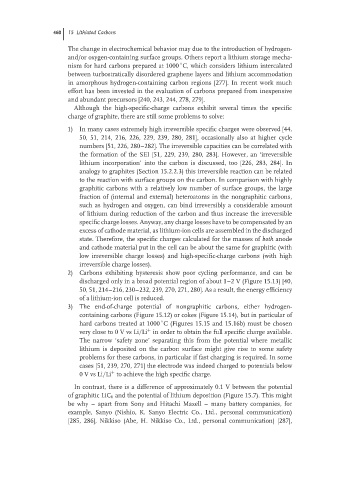Page 487 - Handbook of Battery Materials
P. 487
460 15 Lithiated Carbons
The change in electrochemical behavior may due to the introduction of hydrogen-
and/or oxygen-containing surface groups. Others report a lithium storage mecha-
◦
nism for hard carbons prepared at 1000 C, which considers lithium intercalated
between turbostratically disordered graphene layers and lithium accommodation
in amorphous hydrogen-containing carbon regions [277]. In recent work much
effort has been invested in the evaluation of carbons prepared from inexpensive
and abundant precursors [240, 243, 244, 278, 279].
Although the high-specific-charge carbons exhibit several times the specific
charge of graphite, there are still some problems to solve:
1) In many cases extremely high irreversible specific charges were observed [44,
50, 51, 214, 216, 226, 229, 239, 280, 281], occasionally also at higher cycle
numbers [51, 226, 280–282]. The irreversible capacities can be correlated with
the formation of the SEI [51, 229, 239, 280, 283]. However, an ‘irreversible
lithium incorporation’ into the carbon is discussed, too [226, 283, 284]. In
analogy to graphites (Section 15.2.2.3) this irreversible reaction can be related
to the reaction with surface groups on the carbon. In comparison with highly
graphitic carbons with a relatively low number of surface groups, the large
fraction of (internal and external) heteroatoms in the nongraphitic carbons,
such as hydrogen and oxygen, can bind irreversibly a considerable amount
of lithium during reduction of the carbon and thus increase the irreversible
specific charge losses. Anyway, any charge losses have to be compensated by an
excess of cathode material, as lithium-ion cells are assembled in the discharged
state. Therefore, the specific charges calculated for the masses of both anode
and cathode material put in the cell can be about the same for graphitic (with
low irreversible charge losses) and high-specific-charge carbons (with high
irreversible charge losses).
2) Carbons exhibiting hysteresis show poor cycling performance, and can be
discharged only in a broad potential region of about 1–2 V (Figure 15.13) [40,
50, 51, 214–216, 230–232, 239, 270, 271, 280]. As a result, the energy efficiency
of a lithium-ion cell is reduced.
3) The end-of-charge potential of nongraphitic carbons, either hydrogen-
containing carbons (Figure 15.12) or cokes (Figure 15.14), but in particular of
◦
hard carbons treated at 1000 C (Figures 15.15 and 15.16b) must be chosen
very close to 0 V vs Li/Li in order to obtain the full specific charge available.
+
The narrow ‘safety zone’ separating this from the potential where metallic
lithium is deposited on the carbon surface might give rise to some safety
problems for these carbons, in particular if fast charging is required. In some
cases [51, 239, 270, 271] the electrode was indeed charged to potentials below
0VvsLi/Li to achieve the high specific charge.
+
In contrast, there is a difference of approximately 0.1 V between the potential
of graphitic LiC 6 and the potential of lithium deposition (Figure 15.7). This might
be why – apart from Sony and Hitachi Maxell – many battery companies, for
example, Sanyo (Nishio, K. Sanyo Electric Co., Ltd., personal communication)
[285, 286], Nikkiso (Abe, H. Nikkiso Co., Ltd., personal communication) [287],

